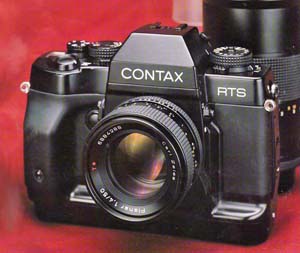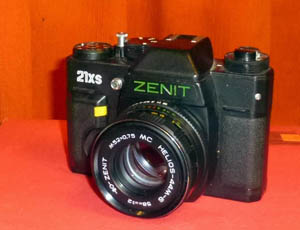Contax Cameras
| Click here for Leica cameras. |
Contax started building its cameras in 1932 using the best German optical and mechanical technologies. Its factories were in Dresden and Jena. Contax cameras were technically ahead of Leica brands. However, both Dresden and Jena were occupied by Soviet troops in 1945 and became East German cities. Soviets took much of the Contax facilities to the Soviet Union to reinforce their camera industry.
- Yet, Germans worked hard to rebuild their Contax empire separately in
Dresden (East Germany) and in Stuttgart (West Germany). Stuttgart was
and still an industrial city producing Benz cars. This city had enough
industrial resources to build quickly a Contax factory.
In Dresden, even under the Communist rule, those diligent German's were able to reconstruct the Contax factories. Thanks to Willy Brandt's Ostpolitik in 1970, East Germans were able to export their industrial products to the Western world. The Contax cameras from Dresden were available in camera stores in the United States as well as in all European countries.

- Contax IIIa (made in Stuttgart, West
Germany). This Contax model seriously challenged Leica's dominance
in the camera market in the 1950s. Japanese started started marketing
their cameras to the world only after 1960. This Contax camera was
technologically ahead of their Leica counterparts. It has a built-in
light meter without battery. Cesium emits enough photo-electrons to
mode the meter needle. At that time, it was unthinkable to attach
bulky batteries to cameras.
Contax was also the first one to use coated optics for color photography. Its lenses were manufactured by Carl Zeiss which is still regarded as the No. 1 lens company in the world. These days, Sony sells some of its digital cameras with Carl Zeiss lenses.
Unfortunately this camera is not mine. One of my friends told me he also has a Leica camera when I was bragging about my Leica. He showed this camera to me. I told him this is a Contax, not Leica. I of course told him his Contax is better than any of the Leica models in the 1950s. This was even true.
- Contax SLR (made in Dresden, East Germany).
This is the Contax camera I almost bought. I like Contax cameras
because they carry lenses made by Carl Zeiss. Zeiss lenses are still
regarded as better than those for Leica cameras. Thus, Contax owners used
to bragg about their cameras. However, I did not buy this camera for the
following reasons.
- This camera was strikingly similar to the
Zenit Russian camera which I bought in Minsk
(Belarus). Yes, Russians took much of Contax dedigns and technolgies to
their country after World War II. If these two cameras are similar, there
is a good reason.
- The camera industry started poducing high-density film cameras,
called APS cameras. I forgot what APS meant. Digital cameras were
still beyond imagination in the 1990s.
- After 1990, I started travelling around the world. I needed small pocket cameras.
- This camera was strikingly similar to the
Zenit Russian camera which I bought in Minsk
(Belarus). Yes, Russians took much of Contax dedigns and technolgies to
their country after World War II. If these two cameras are similar, there
is a good reason.
Aim-and-Shoot Cameras
By 1990, the camera industry developed auto-focusing system, and started producing aim-and-shoot pocket cameras. They were inexpensive and easy to carry around. They were very convenient for travellers. Neither Leica nor Contax was producing those convenient cameras.
- On the other hand, Contax was cooperating with Japan's Kyocera
company which used to produce Yashica cameras. I bought one of those
Yashica cameras and took many photos while travelling around European
countries. Indeed, many of the photos on my web site were taken with
this Yashica aim-and-shoot camera. Alas, Contax and Kyocera broke up
after cameras became digital. Kyocera could not produce digital
cameras.
Sony was quick to pick up the lens system of Contax, and there are Sony cameras with Carl Zeiss lenses. Thus, the best way to insist on the Contax tradition is to carry Sony cameras with those Zeiss lenses.
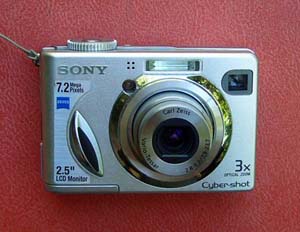
- Sony Cyber-shot W-7. Sony was
somewhat late in camera industry. It needed a prestigious name for
its lenses. It decided to equip their digital with Carl Zeiss
lenses which used to be on Contax cameras.
I bought this Sony camera because, in addition to its Carl Zeiss lens, it could be powered by two AA batteries. Even in 2005, rechargeable batteries did not last long. Thus, for extended trips, I had to carry this camera which accepts batteries locally available. In addition, it has an optical view finder.
In 2005, I carried this camera when I went to the Russian city of Kaliningrad in order to study Einstein's philosophical background. I created a webpage based on the photos I took there. You are invited to this page.
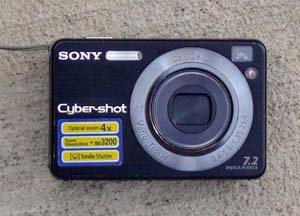
-
with Zeiss lens and a memory stick (top), with Zeiss lens and a
SD card (bottom).
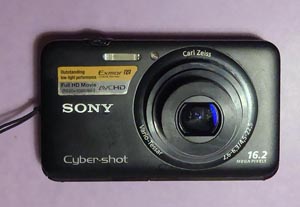
- Sony Cyber-shot W-120. This is
one of the current versions in Sony's Cyber-shot series, with all
the advanced technical features. It also has an optical view finder,
but does not take AA batteries. But camera batteries are now much
more powerful. This is a very convenient pocket camera for travellers.
However, the Sony cameras use their own memory sticks which cannot be inserted into laptop computers. Laptops accept only SD cards. Sony realized this problem and started making new models with SD cards.
- Sony Cyber-shot WX-9. Indeed, this
model addresses this problem, and this model used the SD card. Furthermore,
the battery can be recharged through a USB cable from the laptop. This
camera is thus quite compatible with travellers.
Some Sony cameras come with Carl Zeiss lenses, and some with their own Sony lenses. I always choose those with Zeiss lenses. Sony is OK in electronics. These days, Samsung seems to be expanding its camera market share. I may eventually have to buy one of the Samsung models, but I do not know when.
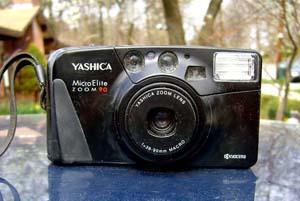
- Yashica. For about 15 years,
Contax was marketing Contax cameras through Japan's Kyocera company.
Kyocera used to make its own brand called Yashica. Yashica did not
reach the level of Canon or Nikon in the camera market, but it used
to produce fine practical cameras. The Yashica camera was developed
initially by the Seiko watch company. I used to bring this
Yashica camera whenever I traveled to foreign countries until 2001.
My website contains many photos I took with this Yashica camera.
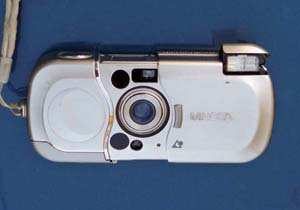
- Minolta APS. Before digital
cameras became popular, Kodak started marketing high-density films
called APS (Advanced Photo System) films. Indeed, APS photos give
better webpages, and many of the photos in my website came from
photos from this Minolta APS camera. Unfortunately, the APS system
could not survive in the digital age.
These days, Minolta factories are making Sony digital cameras.
I went to the Nice Beach (Cote d'Azur) in southern France with my Minolta APS in 2002, and went there again in 2006 with Sony Cybershot W-7. I took pictures there. Here are some of them.
- Click here for my Leica cameras.
Who is responsible for this webpage?
Click here for his home page. or
click here for his style page.
copyright@2013 by Y. S. Kim, unless otherwise specified.
